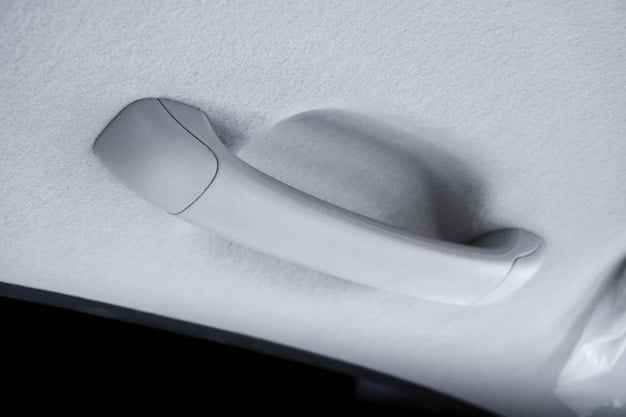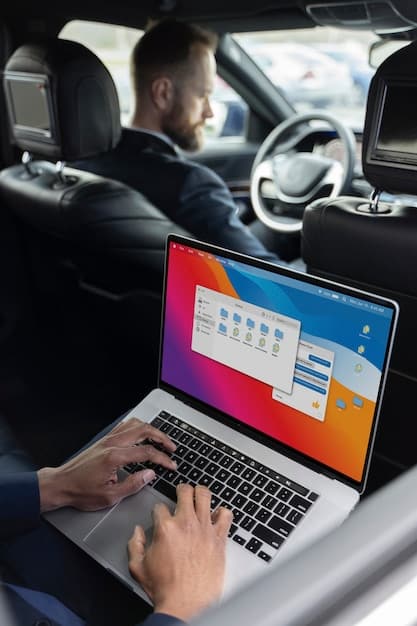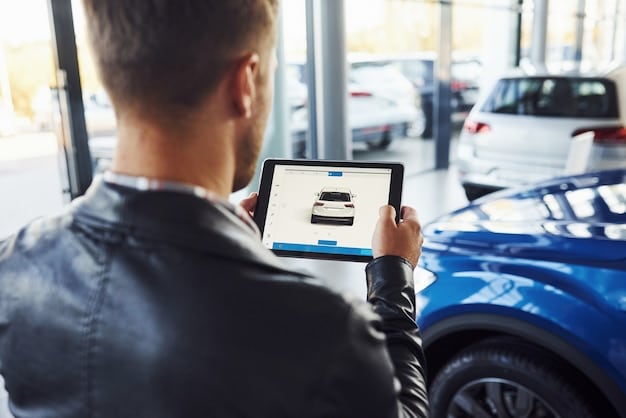How to Trade In Your Car in 2025: A Complete Guide

Trading in your car in 2025 requires understanding current valuation trends, preparing your vehicle for appraisal, researching dealer incentives, and strategically negotiating to maximize your trade-in value before buying a new car.
Planning to trade in your car in 2025? Navigating the trade-in process can be daunting, but with the right knowledge, you can ensure you get the best possible value. This guide provides a comprehensive overview of how to trade in your car in 2025: maximizing your trade-in value before you buy.
Understanding the 2025 Car Market
To successfully trade in your car in 2025, it’s crucial to understand the broader market dynamics. Several factors, including economic conditions, technological advancements, and consumer preferences, can influence the value of your trade-in.
Economic Factors Affecting Car Values
The overall economic health of the country plays a significant role in car values. Here’s how:
- Inflation Rates: Higher inflation can drive up the prices of new cars, indirectly increasing the value of used cars as buyers seek more affordable options.
- Interest Rates: Increasing interest rates can make financing a new car more expensive, potentially boosting the demand for used vehicles.
- Unemployment Rates: A strong job market usually leads to increased consumer confidence and spending, which can help maintain or even increase car values.
- Supply Chain Issues: Continued disruptions in the supply chain can limit the availability of new cars, thereby driving up the demand and prices for used cars.
Technological Advancements in 2025
Technological advancements continue to reshape the automotive landscape. Here’s what to watch for:
- Electric Vehicles (EVs): The increasing popularity of EVs could affect the demand and value of traditional gasoline-powered cars.
- Autonomous Driving Features: Cars equipped with advanced driver-assistance systems (ADAS) may hold their value better than those without these features.
- Connectivity and Infotainment: Modern infotainment systems and connectivity features are becoming increasingly important to buyers, so ensure your car has up-to-date technology.
Staying informed about these market forces will help you better assess your car’s current and future value. It’s essential to monitor these trends as you prepare to trade in your vehicle.
Assessing Your Car’s Current Value
Before heading to the dealership, it’s essential to get an accurate estimate of your car’s worth. Knowing its value will give you a strong negotiating position. Use online valuation tools, consider its condition, and understand the local market.

Online Valuation Tools
Several websites offer tools to estimate your car’s trade-in value. Popular options include:
- Kelley Blue Book (KBB): Known for its comprehensive data and detailed valuation reports.
- Edmunds: Offers a similar service with additional insights and user reviews.
- NADAguides: Provides values based on the National Automobile Dealers Association data.
Be sure to input accurate information about your car, including its make, model, year, mileage, and condition. Keep in mind that these are estimates, and the actual trade-in value may vary.
Condition Matters: Inside and Out
The condition of your car plays a significant role in its valuation. Here’s what to consider:
- Exterior Condition: Address any dents, scratches, or rust spots. A clean and well-maintained exterior can significantly increase the perceived value.
- Interior Condition: Clean the interior thoroughly, removing any stains, odors, or debris. Repair any tears or damage to the upholstery.
- Mechanical Condition: Ensure your car is in good working order. Address any known mechanical issues, such as engine problems, transmission issues, or brake repairs.
Keep detailed maintenance records to show potential buyers that you’ve taken good care of your car. Regular servicing and prompt repairs can positively influence the trade-in value.
By using valuation tools and carefully assessing the condition of your car, you can get a realistic estimate of its value. This knowledge will empower you during the trade-in negotiation process, helping you secure a fair deal.
Preparing Your Car for Trade-In
Proper preparation can significantly impact the trade-in value of your car. Beyond basic cleaning, address minor repairs, gather all necessary documents, and consider detailing. Small investments can lead to a higher appraisal.
Minor Repairs and Maintenance
Addressing minor issues before trading in your car can make a big difference:
Focus on:
- Replacing worn tires: New tires can greatly improve the appearance and perceived value of your car.
- Fixing small dents and scratches: Minor cosmetic repairs can prevent dealerships from haggling over these issues.
- Replacing burnt-out bulbs: Ensure all lights are working, including headlights, taillights, and interior lights.
- Changing fluids: Fresh oil, coolant, and brake fluid can reassure the dealer that your car has been well-maintained.
It’s often worth investing in these small repairs to increase your car’s appeal and value.
Gathering Essential Documents
Having all the necessary paperwork ready can streamline the trade-in process:
- Vehicle Title: Ensure the title is clear and free of liens. If you have a loan on the car, know the exact payoff amount.
- Registration: Bring your current vehicle registration.
- Maintenance Records: Provide records of all maintenance and repairs, demonstrating that the car has been well cared for.
- Warranty Information: Include any remaining warranty coverage.
- Driver’s License or ID: Bring a valid form of identification.
Being organized with your documents will save time and demonstrate your preparedness to the dealer.
Professional Detailing vs. DIY Cleaning
Before trading in, decide how thorough you want to be with cleaning:
- Professional Detailing: A professional detailing service can deep clean and restore your car’s interior and exterior, removing stubborn stains and odors.
- DIY Cleaning: If you prefer to clean yourself, focus on vacuuming the interior, washing and waxing the exterior, and cleaning the windows and mirrors.
The goal is to present your car in the best possible light. A clean and well-maintained vehicle is more likely to fetch a higher trade-in value. Consider which approach aligns best with your budget and time constraints.
By taking the time to prepare your car, you show dealers that you value your vehicle and have taken good care of it. This can lead to a higher trade-in offer and a smoother negotiation process. Remember, presentation matters, and even small efforts can yield significant returns.
Researching Dealer Incentives and Rebates
Before you start negotiating, it’s important to research any dealer incentives and rebates that you might qualify for. These can significantly lower the cost of your new car, indirectly increasing the value you get from your trade-in.

Manufacturer Rebates
Be sure to investigate and ask the dealer about:
- Cash-Back Offers: Many manufacturers offer cash rebates on new car purchases.
- Low-Interest Financing: Some manufacturers provide attractive financing options with low interest rates.
- Lease Deals: Check for special lease offers that can reduce your monthly payments.
These rebates can dramatically lower the overall cost of your new car, making your trade-in value seem even more significant.
Dealer Incentives and Special Programs
Many manufacturers offer incentives to dealers for meeting sales goals. These incentives can translate into savings for you. Some examples are:
- Sales Volume Bonuses: Dealers may be more willing to offer a better trade-in value to meet monthly or quarterly sales quotas.
- Inventory Clearance: As new models arrive, dealers often offer discounts on older models to clear inventory.
- Special Programs: Some dealers participate in programs that offer additional discounts or incentives to specific groups, such as military personnel, students, or recent graduates.
Inquire about any special programs or incentives that could apply to you. Don’t hesitate to ask the dealer directly about any available discounts.
Combining Incentives for Maximum Savings
In some cases, you can combine multiple incentives to maximize your savings. Try to:
- Stack Rebates: Ask if you can combine manufacturer rebates with dealer incentives.
- Negotiate Financing: Compare financing options from different lenders, including the dealer’s financing and your bank or credit union.
- Time Your Purchase: Consider buying at the end of the month or quarter when dealers are more eager to meet sales goals.
Carefully research and combine incentives to substantially reduce the price of your new car, which will make your trade-in value more impactful.
By thoroughly researching dealer incentives and rebates, you can negotiate from a position of strength. These savings can make your trade-in value go further and help you get the best possible deal on your new car. Always ask about all available incentives and don’t be afraid to negotiate for the best possible outcome.
Negotiating the Trade-In Value
The negotiation process is critical when trading in your car. Be prepared to negotiate, understand the dealer’s perspective, and focus on the total cost difference rather than just the trade-in value.
Understanding the Dealer’s Perspective
Dealers aim to make a profit. They will assess your car’s current market value, potential resale value, and any reconditioning costs. Remember, dealers have expenses and profit margins to consider. It’s important to:
Consider these points:
- Profit Margins: Dealers need to make a profit to stay in business.
- Reconditioning Costs: Dealers must factor in the cost of cleaning, repairing, and reconditioning your car for resale.
- Market Demand: The demand for your car model in the local market will influence the trade-in value.
Understanding these factors will help you understand the dealer’s offer and negotiate more effectively.
Focusing on the “Out-the-Door” Price
Instead of fixating solely on the trade-in value, focus on the “out-the-door” price. This is the total price of the new car, including all taxes, fees, and any other charges.
- Calculate the Difference: Determine the difference between the out-the-door price and the final trade-in value.
- Compare Offers: Compare the total cost difference from multiple dealerships.
This approach allows you to evaluate the entire deal and ensure you’re getting the best overall value.
Negotiation Techniques
Effective negotiation can lead to a better trade-in value and overall deal. Try these techniques:
- Get Multiple Offers: Obtain trade-in quotes from several dealerships. Use these offers as leverage during negotiation.
- Be Prepared to Walk Away: Dealers are more likely to offer a better deal if they know you’re willing to walk away.
- Negotiate Separately: Negotiate the price of the new car and the trade-in value separately to avoid confusion and ensure you’re getting the best possible value on both.
By understanding the dealer’s perspective, focusing on the total cost difference, and employing effective negotiation strategies, you can maximize your trade-in value and secure a favorable deal.
Negotiating the trade-in value requires preparation and a strategic approach. Remember, knowledge is power. The more you know about your car’s value, market conditions, and dealer incentives, the better equipped you’ll be to get a fair deal. Stay calm, be professional, and don’t be afraid to walk away if the offer doesn’t meet your expectations. The goal is to find a deal that works for you, both in terms of the trade-in value and the overall cost of the new car.
Navigating the Trade-In Process at the Dealership
Once you’ve prepared and researched, understanding how the trade-in process unfolds at the dealership is key. From appraisals to finalizing paperwork, each step requires attention to detail.
The Appraisal Process
The dealership will conduct a thorough appraisal of your car. Be sure to be present during the process to answer any questions and point out any features or maintenance you’ve performed.
The appraisal typically involves:
- Visual Inspection: Assessing the exterior and interior condition.
- Mechanical Check: Evaluating the engine, transmission, brakes, and other mechanical components.
- Test Drive: Checking the car’s performance on the road.
- Valuation: Using market data and industry tools to determine the car’s value.
The dealer will use this evaluation to make you an offer.
Reviewing the Trade-In Offer
Carefully review the trade-in offer. Don’t feel pressured to accept the first offer. Compare it to your research and any other offers you’ve received.
- Check the Details: Ensure the offer accurately reflects your car’s make, model, year, and condition.
- Understand the Terms: Clarify any fees or charges associated with the trade-in.
- Ask Questions: Don’t hesitate to ask the dealer to explain any aspects of the offer that you don’t understand.
Taking your time to review the offer ensures you’re making an informed decision.
Completing the Paperwork
Once you’ve agreed to the trade-in value, you’ll need to complete the necessary paperwork. Be thorough and ensure all documents are accurate.
- Title Transfer: Complete the title transfer form to transfer ownership of the car to the dealership.
- Sales Agreement: Review the sales agreement to ensure it accurately reflects the agreed-upon price, trade-in value, and any other terms.
- Odometer Disclosure: Complete the odometer disclosure statement to certify the car’s mileage.
Double-check all documents before signing to avoid any potential issues later.
Navigating the trade-in process at the dealership requires patience and attention to detail. By understanding each step, from the appraisal to the final paperwork, you can ensure a smooth and successful transaction. Remember to stay informed, ask questions, and don’t hesitate to seek clarification if needed. The goal is to drive away with a new car and the peace of mind that you’ve made a well-informed decision.
| Key Point | Brief Description |
|---|---|
| 💰 Research Values | Use tools like KBB and Edmunds to estimate your car’s value. |
| 🛠️ Prepare Your Car | Clean, repair minor issues, and gather all necessary documents. |
| 📈 Negotiate Smartly | Focus on the total “out-the-door” price, not just the trade-in value. |
| 🤝 Multiple Offers | Get offers from multiple dealerships to increase your negotiating power. |
Frequently Asked Questions
▼
You’ll typically need your vehicle title, registration, maintenance records, warranty information, and a valid driver’s license or ID to trade in your car.
▼
To increase your car’s trade-in value, clean it thoroughly, address minor repairs, gather all necessary documents, and research dealer incentives and rebates.
▼
Yes, fixing minor issues such as dents, scratches, and burnt-out bulbs can increase your car’s trade-in value by making it more appealing.
▼
To negotiate a better trade-in value, get multiple offers, be prepared to walk away, and focus on the total cost difference rather than just the trade-in value.
▼
The appraisal process involves a visual inspection, a mechanical check, a test drive, and a valuation using market data to determine the car’s worth.
Conclusion
Trading in your car in 2025 requires careful planning, research, and negotiation. By understanding market trends, preparing your vehicle, and strategically negotiating with dealers, you can maximize your trade-in value and drive away with a new car you love.





